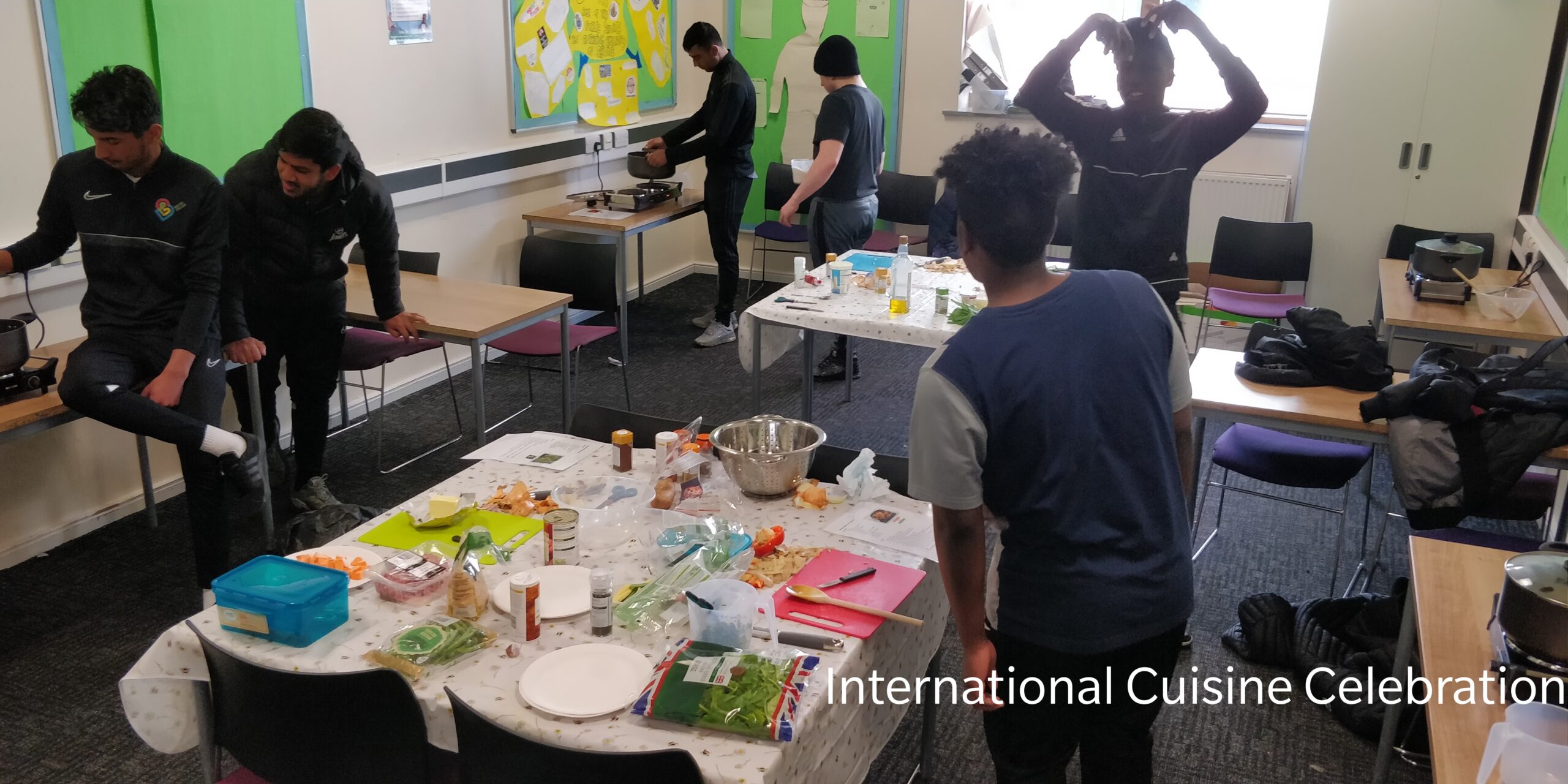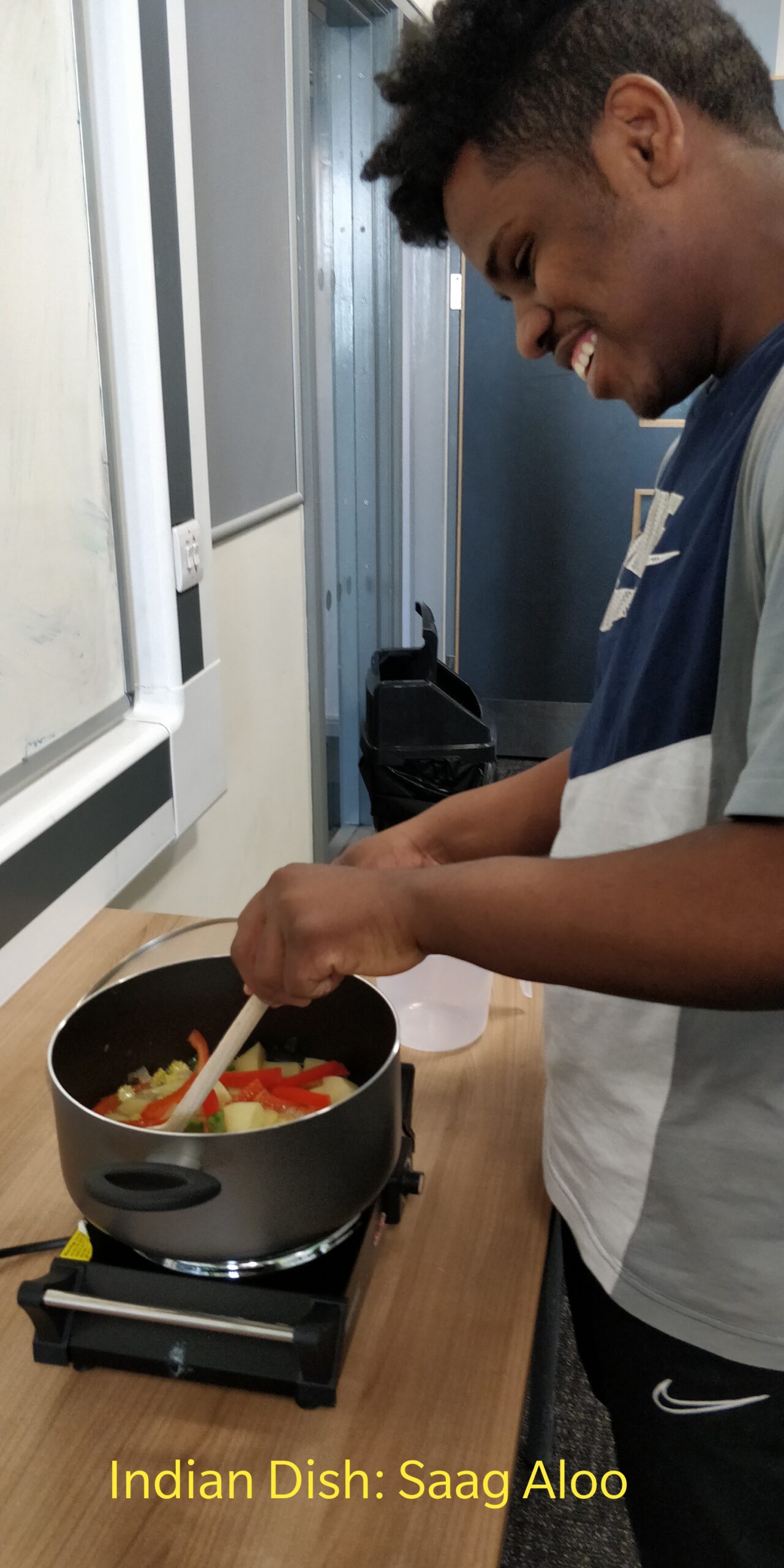We got cooking with a group of students at Bolton College in a 3 week week project focused on celebrating foods from our different cultures! We delivered an International Cuisine Celebration in partnership with Bolton Wanderers in the Community.
Over the last three weeks I have been lucky enough to work alongside Bolton Wanderers in the community, with a group of amazing young men, discovering their culinary backgrounds, likes and dislikes, teaching them kitchen skills, nutritional knowledge, cooking some delicious recipes and tasting some amazing food from Europe and Asia.
Week 1 – Fish and Chips!
Week 1 began with talking about our own experiences, both in terms of food preparation and food that we were accustomed to eating and food that we had previously enjoyed. Everyone recalled dishes that made them smile; meals that were comforting and familiar, and meals that were family favourites. However, many of the group said that they had never prepared a meal before. This was obviously something that we at Classroom Kitchen were determined to put right!
We discussed how the three weeks would run and began to think about the dishes that would represent our own traditions and food habits. After taking a virtual world tour of national dishes, which tested our geographical and culinary knowledge, the group were beginning to get an idea of a dish that they would like to cook on Week 3 for the ‘International Cuisine Celebration’. The group were also getting hungry, so we knew it was time to get cooking!
As we were in Northern England, we decided that the dish for today had to be Fish and Chips. The group set to work, slicing the potatoes, coating the fish, and preparing the mushy peas. Whilst the food was cooking, the students learnt how the ingredients were sourced, the nutritional make-up of the meal and some of the history of how Fish and Chips became such an iconic English dish. Once this traditional English, Friday night treat was ready, we tucked in…
Whilst enjoying the food, the students were asked to consider the appearance of the food, the smell, the texture, and the taste. A word bank was shared to support then in giving their appraisal. This gave rise to a great discussion about some of the vocabulary, umami, tangy and zesty provoked good conversation. Everyone was looking forward to week 2, when we would spread our gastronomic wings and head south, to Africa.

Week 2 – Djerma Stew!
Week 2 was our first chance as a group to look outside the UK for food inspiration. The dish of the day was Djerma Stew, the national dish of the African nation of Niger. This is sometimes called a peanut stew as the recipe calls for peanut butter. For allergenic reasons, we substituted the peanut butter for tahini sauce (I can smell this even as I am typing…delicious!). The recipe also had chicken, onions, garlic, chopped tomatoes, bay leaves, carrots, parsley, chives, paprika, thyme and curry powder. It really was as tasty as it sounds.
After chopping, slicing, crushing, dicing, softening, stirring, boiling, and simmering, the lads tucked in and, needless to say, it was a real hit; empty plates all round.
The group had used all the kitchen skills we had learned over the two sessions so far with great results. Some had cooked a meal for the first time ever. They could discuss the nutrition in the food, the balance of the meal and used new vocabulary to describe their experience. In week 3, they had a chance to share a small part of their own culinary culture as we held our ‘International Cuisine Celebration’

Week 3 – International Cuisine Celebration!
Week 3 saw the students preparing and cooking meals of their own choice. The group had chosen dishes that represented their culture, and as we were working in four groups, we had four different meals to make. One group cooked a Lamb Kima, to represent Pakistan. The next group opted for Penne con Salsiccia, a pasta and sausage dish from Italy. The third group decide upon Burani Katchalu, an Afghan dish of potatoes, onions, and tomatoes, seasoned with garlic, coriander, and chilli. The last fare on offer was and Indian Curry, Saag Aloo. The range of international cuisine was great to see, and we looked forward to the tasting session that was to come.
The lads followed the recipes carefully and once again put their newfound kitchen skills to good use. The students had also become quite adept at seasoning their food; gauging how much of each ingredient would suit the dish. Curry powder, chilli, ginger, cinnamon, garlic, salt and pepper all made an appearance. Once the group were happy and the pans had simmered for just the right amount of time, it was moment of truth, the taste test.
All the plates were judged on four criteria; appearance, smell, texture and taste, and the students used the word bank to add descriptions of the food. All the dishes were a success.
It was very difficult to choose a winning dish as each group had cooked up a really tasty meal. However, the scores were in and the dish that rated the highest was the Pakistani Lamb Kima, described by the group as ‘luscious, velvety, vibrant, and flavourful!’
It is safe to say that the three-week project had indeed been a ‘celebration of international cuisine’. Everyone had learnt new kitchen skills, cooked themselves a meal (some of the group for the first time ever), tried new food, tried new flavours, and worked as part of the group to share their culture.
The whole process has been such a rewarding experience. These young men came together, proudly shared their heritage, learned and applied new skills, worked as a team and respectfully gave feedback on the efforts of the classmates.
Result! 😊
Behind the rambling…
For anyone who doesn’t know me or hasn’t met me before, I’m Richard Halton, an Activity Coordinator for Classroom Kitchen.
Email: rhalton@classroom-kitchen.co.uk











